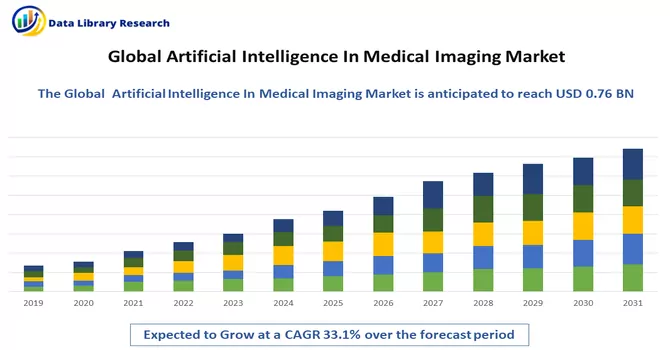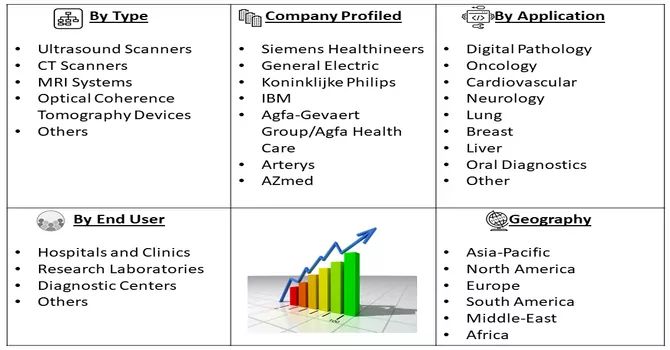The global AI in medical imaging market size was estimated at USD 0.76 billion in 2022 registering a CAGR of 33.1% during the forecast period 2023 to 2030.

Get Complete Analysis Of The Report - Download Free Sample PDF
The diagnostic process known as medical imaging may be characterized as the generation of visual aids and picture representations of the human body, as well as the observation of the performance and functionality of the human organs. Artificial intelligence (AI) is changing how diagnoses and the whole procedure are carried out in the healthcare and medical imaging fields.
Segmentation:
The AI in Medical Imaging Market is Segmented
By Modality:
By End User:
Application:
Geography :
The report offers market sizes and forecasts in value (USD million) for the above segments.

For Detailed Market Segmentation - Download Free Sample PDF
Deep learning algorithms, particularly convolutional neural networks (CNNs), have gained prominence in medical imaging. They excel in image recognition tasks and are increasingly being used for tasks such as tumor detection, pathology analysis, and image segmentation. AI is enabling the move toward personalized medicine by analyzing medical images to tailor treatment plans and interventions based on individual patient data. This trend is particularly relevant in oncology, where AI helps identify the most effective treatment options for specific cancer types.
Drivers:
Increasing Demand for Accurate and Efficient Diagnosis
AI-powered medical imaging solutions significantly enhance the accuracy and efficiency of disease diagnosis. They enable healthcare providers to detect anomalies and interpret imaging data with greater precision, ultimately improving patient outcomes.
Technological Advancements in AI and Imaging Equipment
Advancements in AI algorithms and the availability of more advanced imaging equipment have fueled the adoption of AI in medical imaging. These technologies offer enhanced image quality and data analysis capabilities, making AI integration more appealing. For instance, In June 2021, VUNO Inc., a South Korean AI business, announced a strategic partnership with Samsung Electronics for the incorporation of the AI-powered mobile digital X-ray system VUNO Med-Chest X-ray within the GM85. This partnership is projected to bring VUNO closer to the expansion of AI applications that are market-ready due to its access to the global market.
Restraints:
High Implementation Costs and Data Privacy and Security Concerns
The initial cost of implementing AI solutions in medical imaging, including purchasing AI software and upgrading imaging equipment, can be prohibitive for some healthcare facilities, especially in resource-constrained regions. Handling patient data in medical imaging requires stringent security measures. Concerns regarding data privacy breaches and cybersecurity threats may hinder the adoption of AI in this sector.
The COVID-19 pandemic has acted as a catalyst for the advancement of AI technologies, providing opportunities to leverage these tools for the betterment of healthcare. AI and radiomics have been harnessed for augmented imaging techniques in the detection and monitoring of COVID-19 infections through the use of X-rays and CT scans. For instance, Zhongnan Hospital in China employed AI to interpret CT scans and identify COVID-19 symptoms in cases where human radiologists were not readily available. This accelerated adoption of AI has played a pivotal role in the swift response to the pandemic's diagnostic challenges.
Segmental Analysis:
Deep Learning Segment is Expected to Witness Significant Growth over the Forecast Period
Deep learning has revolutionized the field of medical imaging by enabling more accurate, efficient, and automated analysis of medical images. Deep learning is a subset of artificial intelligence (AI) that uses neural networks with multiple layers to automatically learn patterns and features from data. In medical imaging, deep learning has found numerous applications, making it a powerful tool for healthcare professionals. Deep learning models can classify and detect abnormalities in medical images with high accuracy. For example, deep learning algorithms can identify tumors in X-rays, CT scans, and MRI images, helping radiologists make faster and more precise diagnoses.
Neurology Segment is Expected to Witness Significant Growth over the Forecast Period
The neurology segment held the largest share owing to the increased use of AI in neurology as it enables higher accuracy, better patient care, and high efficiency. Additionally, AI is used in neuro-oncology, neuro-vascular disease detection, neurosurgery, and traumatic brain injury detection. Neurology and medical imaging are closely intertwined fields in healthcare, with medical imaging playing a critical role in the diagnosis, treatment, and management of neurological disorders. Neurology is the branch of medicine that deals with disorders of the nervous system, including the brain, spinal cord, and peripheral nerves. Medical imaging techniques have significantly advanced the understanding and treatment of neurological conditions. MRI is the primary imaging modality for diagnosing and monitoring MS. It can detect the presence of demyelinating lesions in the brain and spinal cord, helping clinicians establish a diagnosis and assess disease progression. Thus, owing to such benefits the segment is expected to witness significant growth over the forecast period.
Asia-Pacific The region is Expected to Witness Significant Growth over the Forecast Period
the Asia-Pacific, artificial intelligence in healthcare is expected to witness lucrative growth over the forecast period, owing to rising R&D expenditure and developments in the pharmaceutical and biotechnology sectors. The presence of a significant patient pool will trigger demand for better healthcare services, develop healthcare infrastructure, and increase disposable income to support further the growth of AI in Medical Imaging in the region. Furthermore, spending in the healthcare sector gained heightened traction. Economies in the region are increasingly concentrating on developing a robust healthcare infrastructure for patient diagnoses and treatment. According to Invest India, India's hospital sector, accounting for 80% of the total healthcare market, is observing significant investor interest from both global and domestic investors.

Get Complete Analysis Of The Report - Download Free Sample PDF
Some prominent players in the global AI in medical imaging market include:
Recent Developments:
1) In July 2022, the FDA gave Philips SmartSpeed AI-based software its 510(k) approval, enabling it to offer ground-breaking high-speed, high-resolution MR imaging. Its wide compatibility enables quicker and higher-quality scans for almost all patients with a variety of illnesses, including those with implants (97% of clinical protocols). In addition, the intelligent MR acceleration software offers 3 times quicker scans, which increases MR department efficiency with high-quality picture resolution.
2) In May 2021, ThinkCyte, an AI-based medical imaging company, and Sysmex Corporation collaborated to improve the accuracy of diagnoses and enhance treatment. In addition, both companies are working to develop novel testing and diagnostic technologies. These technologies have high clinical value. Meanwhile, digitalization is accelerating in areas of healthcare including AI-powered medical image processing and robotically assisted testing.
Q1. How big is the Artificial Intelligence in Medical Imaging Market?
The global AI in medical imaging market size was estimated at USD 0.76 billion in 2022 registering a CAGR of 33.1% during the forecast period.
Q2. What is the Growth Rate of the Artificial Intelligence in Medical Imaging Market?
Artificial Intelligence in Medical Imaging Market is registering a CAGR of 33.1% during the forecast period.
Q3. What are the Growth Drivers of the Artificial Intelligence in Medical Imaging Market?
Increasing Demand for Accurate and Efficient Diagnosis and Technological Advancements in AI and Imaging Equipment are the Growth Drivers of the Artificial Intelligence in Medical Imaging Market.
Q4. Which are the major companies in the Artificial Intelligence in Medical Imaging Market?
Siemens Healthineers, General Electric, Koninklijke Philips and IBM are some of the Artificial Intelligence in Medical Imaging Market.
Data Library Research are conducted by industry experts who offer insight on industry structure, market segmentations technology assessment and competitive landscape (CL), and penetration, as well as on emerging trends. Their analysis is based on primary interviews (~ 80%) and secondary research (~ 20%) as well as years of professional expertise in their respective industries. Adding to this, by analysing historical trends and current market positions, our analysts predict where the market will be headed for the next five years. Furthermore, the varying trends of segment & categories geographically presented are also studied and the estimated based on the primary & secondary research.
In this particular report from the supply side Data Library Research has conducted primary surveys (interviews) with the key level executives (VP, CEO’s, Marketing Director, Business Development Manager and SOFT) of the companies that active & prominent as well as the midsized organization
FIGURE 1: DLR RESEARH PROCESS

Extensive primary research was conducted to gain a deeper insight of the market and industry performance. The analysis is based on both primary and secondary research as well as years of professional expertise in the respective industries.
In addition to analysing current and historical trends, our analysts predict where the market is headed over the next five years.
It varies by segment for these categories geographically presented in the list of market tables. Speaking about this particular report we have conducted primary surveys (interviews) with the key level executives (VP, CEO’s, Marketing Director, Business Development Manager and many more) of the major players active in the market.
Secondary ResearchSecondary research was mainly used to collect and identify information useful for the extensive, technical, market-oriented, and Friend’s study of the Global Extra Neutral Alcohol. It was also used to obtain key information about major players, market classification and segmentation according to the industry trends, geographical markets, and developments related to the market and technology perspectives. For this study, analysts have gathered information from various credible sources, such as annual reports, sec filings, journals, white papers, SOFT presentations, and company web sites.
Market Size EstimationBoth, top-down and bottom-up approaches were used to estimate and validate the size of the Global market and to estimate the size of various other dependent submarkets in the overall Extra Neutral Alcohol. The key players in the market were identified through secondary research and their market contributions in the respective geographies were determined through primary and secondary research.
Forecast Model
